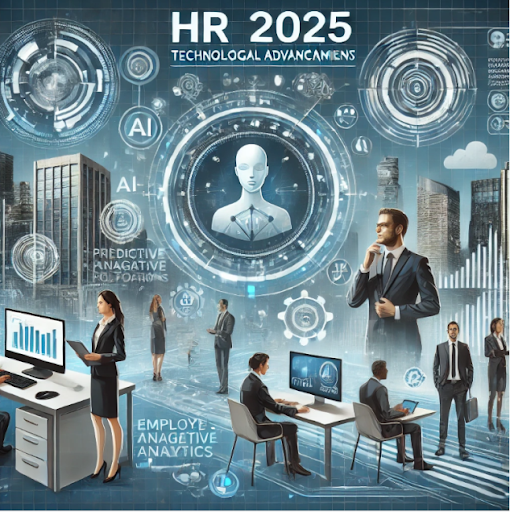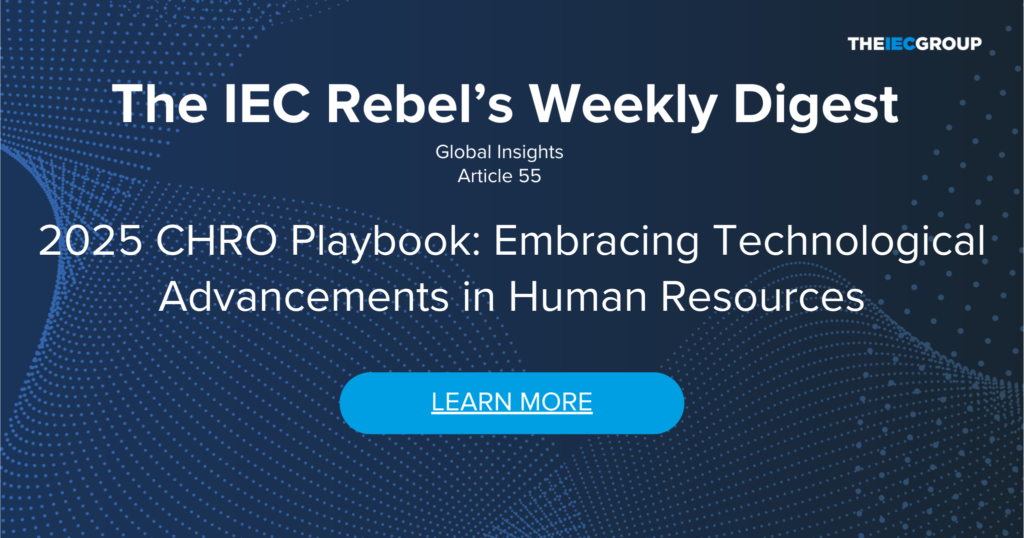2025 CHRO Playbook: Embracing Technological Advancements in Human Resources
Introduction
 As Chief Human Resource Officers (CHROs) look toward 2025, they are tasked with navigating a landscape that is becoming increasingly complex.
As Chief Human Resource Officers (CHROs) look toward 2025, they are tasked with navigating a landscape that is becoming increasingly complex.
Rapid technological advances, evolving workforce expectations, and the need for greater agility have created both challenges and opportunities for HR leaders. Among the top 10 priorities CHROs should focus on to stay ahead, embracing technological advancements stands out as a pivotal area that will shape the future of HR.
Integrating AI, predictive analytics, and other cutting-edge tools can streamline HR functions, enhance the employee experience, and align HR strategies more closely with overarching business goals. This article delves into why technology adoption is so critical for CHROs and outlines practical steps for its successful implementation.
The Critical Role of Technology in HR
Technology has become central to all aspects of business, and HR is no exception. Today’s CHROs face expectations to not only support traditional HR functions but also lead digital transformations that align with business goals. Embracing technology helps HR teams streamline core processes, create data-driven strategies, and foster stronger, more personalized employee experiences. As HR moves from a support role to a strategic driver, technology enables it to shape workplace culture, enhance productivity, and influence long-term organizational success.
Adopting technology within HR is essential for several reasons:
- Efficiency Gains: Automation and AI reduce manual tasks, allowing HR professionals to focus on strategic initiatives.
- Data-Driven Decision Making: Analytics provide insights into workforce trends, employee engagement, and performance, making HR a key player in organizational strategy.
- Enhanced Employee Experience: Technology facilitates personalized and responsive HR services, from onboarding to career development, creating a more satisfying employee journey.
- Agility and Adaptability: Digital tools allow HR to respond swiftly to changes, whether adapting hiring practices or refining employee engagement approaches.
Key Areas for Technological Integration in HR
For CHROs, the top technology priorities lie in the areas of talent acquisition, employee engagement, predictive analytics, and automation. These tools not only modernize HR functions but also enable organizations to stay competitive in the fast-paced digital economy.
- Talent Acquisition and Recruitment
Talent acquisition is one of the areas where technology has the most immediate impact. AI-driven recruitment platforms streamline the hiring process by automating tasks such as resume screening, candidate outreach, and interview scheduling. These tools enable HR teams to focus on building relationships with top candidates and improve the quality of hires by using predictive algorithms to assess the best cultural and skill fits.
- Action 1: Implement AI-powered recruitment tools to enhance efficiency and reduce bias. AI tools can assess resumes based on job requirements and filter candidates accordingly, ensuring that hiring decisions are more consistent and data-driven.
- Action 2: Leverage candidate experience platforms that allow for seamless interactions, from application submission to onboarding, creating a positive initial impression and engaging candidates from the start.
- Employee Engagement and Experience
Employee engagement is a core focus for CHROs, as it directly impacts retention, productivity, and organizational culture. With remote and hybrid work models now prevalent, technology provides HR with tools to connect with employees, gather feedback, and ensure a cohesive culture regardless of location. From pulse surveys to chatbots that address employee inquiries, digital tools can help HR teams maintain a continuous dialogue with employees.
- Action 1: Implement digital feedback platforms that allow employees to provide real-time input. This gives HR insight into engagement levels and potential issues, enabling proactive responses to challenges.
- Action 2: Use AI-driven communication tools and chatbots to answer common employee questions, reducing response times and ensuring employees feel supported, even when HR teams are unavailable.
- Predictive Analytics for Workforce Planning
Predictive analytics are becoming indispensable in workforce planning. By analyzing historical data, HR can identify trends, forecast talent needs, and anticipate issues such as high turnover rates. Predictive models provide CHROs with a competitive edge, allowing them to align workforce strategy with business goals and proactively address staffing needs.
- Action 1: Invest in predictive analytics platforms that gather and analyze data on workforce trends, skill gaps, and retention risks. This helps HR teams make informed decisions about recruitment, development, and resource allocation.
- Action 2: Utilize data to personalize career development plans for employees, ensuring that HR can support both individual and organizational growth by aligning training and development opportunities with anticipated business needs.
- Automating Routine HR Tasks
Automation is revolutionizing routine HR tasks, such as payroll processing, benefits administration, and compliance tracking. Automating these functions reduces administrative burdens and minimizes errors, freeing up HR professionals to focus on higher-impact activities.
- Action 1: Automate payroll and benefits management to streamline processes, improve accuracy, and ensure timely responses to employee inquiries.
- Action 2: Develop workflows for compliance tracking using automated tools, which help HR stay on top of evolving labor laws and regulations while reducing the risk of non-compliance.
Implementing Technology in HR: Steps for CHROs
For CHROs to embrace technological advancements effectively, a strategic approach is essential. Here’s a roadmap for integrating technology within HR operations:
Step 1: Conduct a Technology Needs Assessment
Identify areas within HR where technology could drive the most impact. Assess current HR processes and pinpoint inefficiencies, such as time-consuming manual tasks, poor data accessibility, or gaps in employee experience. The goal is to align technology investments with the areas that need them most urgently.
Step 2: Define Clear Objectives
Establish clear, measurable objectives for each technology initiative. For example, if implementing an AI-powered recruitment tool, define success metrics such as reduced time-to-hire, improved quality of candidates, or increased hiring manager satisfaction. Clear objectives provide focus and facilitate ROI measurement.
Step 3: Foster a Digital-Ready HR Team
Prepare the HR team for technological changes by investing in training and development. Encourage a data-driven mindset within HR, where team members are proficient in analyzing insights and using digital tools. Upskilling HR staff in areas such as data analytics, AI, and software usage ensures successful technology adoption.
Step 4: Partner with IT for Seamless Integration
Collaboration with IT is crucial to ensure that HR technologies integrate smoothly with existing systems. Partnering with IT also helps mitigate cybersecurity risks, maintain data privacy, and optimize the HR tech stack for performance and scalability.
Step 5: Monitor, Measure, and Optimize
Once new technology is in place, continuous monitoring is essential. Regularly evaluate performance metrics, solicit feedback from HR staff and employees, and identify improvement areas. For instance, in recruitment, tracking key performance indicators such as candidate quality, diversity metrics, and retention rates can guide ongoing refinements.
The Benefits of Technological Advancements for HR
Adopting advanced technology in HR provides significant benefits across organizational levels:
- Enhanced Efficiency: Automation and digital tools reduce manual work, streamline processes, and free HR professionals to focus on strategic contributions.
- Improved Decision-Making: Access to real-time data and predictive analytics enables HR to make proactive, evidence-based decisions that align with business objectives.
- Personalized Employee Experience: Technology allows for tailored employee interactions, improving engagement, satisfaction, and overall employee experience.
- Scalability and Agility: Digital solutions equip HR with the flexibility needed to adapt quickly to changing market and workforce demands.
- Stronger Strategic Alignment: By aligning HR initiatives with organizational goals through data-driven insights, CHROs can demonstrate the tangible value HR adds to the business.
Overcoming Challenges in Implementing HR Technology
Despite the benefits, CHROs may encounter challenges when implementing technology in HR:
- Budget Constraints: Many HR departments operate on tight budgets, so prioritizing technology investments based on ROI is crucial.
- Resistance to Change: Employees and even HR staff may resist new technologies. Building a culture of openness and adaptability through communication and training is essential.
- Data Privacy Concerns: HR departments handle sensitive information, making data privacy a top priority. Partnering with IT to ensure robust security protocols is essential.
- Integration Issues: Ensuring that new technologies integrate seamlessly with existing systems can be challenging. Close collaboration with IT can help address compatibility issues.
Conclusion
For CHROs in 2025, embracing technological advancements is no longer optional—it’s essential for HR’s evolution from an operational function to a strategic driver of business value. By leveraging tools like AI, predictive analytics, and automation, HR leaders can create a more efficient, data-informed, and personalized employee experience. However, implementing these technologies requires careful planning, clear objectives, and ongoing monitoring to ensure long-term success. As technology transforms every facet of HR, CHROs have the opportunity to lead their organizations toward a future that is both innovative and people-centered, meeting the demands of the modern workforce while contributing strategically to business outcomes.
By taking a proactive approach to technology adoption, CHROs can not only streamline HR functions but also shape a workplace that attracts, retains, and empowers top talent. The future of HR is digital, and the time to embrace that future is now.
Go To’s: Actions CHROs Should Take After Reading This Article:
- Assess Current HR Technology:
- Conduct an audit of existing HR technologies and identify gaps in automation, analytics, and AI adoption.
- Benchmark against industry trends and competitors to determine areas for improvement.
- Develop a Technology Roadmap:
- Define clear, measurable goals for implementing AI, predictive analytics, and automation in HR processes.
- Prioritize initiatives based on business needs, budget, and potential ROI.
- Invest in AI and Automation Tools:
- Explore AI-driven recruitment platforms and automation solutions to streamline hiring, onboarding, and administrative tasks.
- Ensure tools align with organizational objectives and improve employee experience.
- Upskill the HR Team:
- Provide training on emerging HR technologies and data analytics to empower HR teams to leverage digital tools effectively.
- Foster a digital-first mindset within the HR function.
- Enhance Employee Experience with Digital Solutions:
- Implement engagement and feedback platforms to personalize employee interactions and gather real-time insights.
- Leverage chatbots and self-service portals to improve accessibility and efficiency.
- Collaborate with IT and Leadership:
- Work closely with the IT department to ensure smooth integration of new technologies and data security compliance.
- Align HR tech initiatives with broader business strategies for maximum impact.
- Monitor and Optimize Performance:
- Continuously track HR technology performance and gather feedback to refine processes.
- Adjust strategies based on data insights to enhance efficiency and effectiveness.
Taking these steps will help CHROs lead their organizations through digital transformation and position HR as a strategic business enabler.
Last but not Least: If you’re facing challenges and wondering how others are managing similar issues, why not join The Leadership Collective Community? It’s a peer group and webcast platform designed for leaders to exchange insights and experiences.
Introducing the IEC Knowledge Network Free Membership – Your Gateway to Seamless Access!
We are thrilled to present a new service that goes beyond the ordinary download experience. In addition to offering you the ability to download the things you love, we are delighted to introduce the IEC Knowledge Network Free Membership.
The Free Membership option grants you access to our library of articles and videos, without the need for tedious registrations for each piece of content.
The publication serves as a trusted resource to support executives in their pursuit of sustainable and successful global expansion. In addition the IEC Practitioners are available to discuss your specific challenge in more detail and to give you clear advise..
Take advantage of this valuable resource to accelerate your global expansion journey


